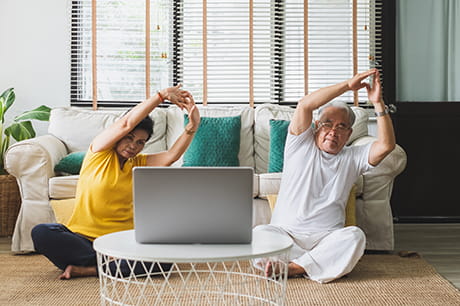Try these 4 exercises to improve balance
Feeling a little off-kilter? These exercises can help boost your balance.
Because of this, it’s important to stay active — not only to improve your balance and prevent falls, but to boost your overall health and fitness.
“Just like strength and flexibility, you can improve you balance by working on it,” says Dr. George Avetian, family medicine doctor at Geisinger 65 Forward Health Center. “And doing so can help you stay steady on your feet.”
Here’s how to improve your balance
Since balance naturally decreases with age, even the nimblest people will need to work on their balance to stay in tip-top shape. The best part? Exercise not only offers physical benefits, but it can boost your mental health, too.“You should try to be active every day, building up to about 150 minutes of moderate exercise per week,” suggests Dr. Avetian. “If you’re new to exercise, be sure to check in with your doctor or healthcare provider to make sure it’s safe for you.”
Looking for exercises to improve your balance? Try one of these:
1. Tai chi
Tai chi, often referred to as “meditation in motion,” involves a series of gentle movements performed slowly and accompanied by deep breathing. And when practiced regularly, it can help increase your flexibility and balance.This exercise targets all the physical components needed to maintain good balance — leg strength, flexibility, range of motion and reflexes.
“Tai chi is a low-impact exercise, so it’s generally safe for all ages and fitness levels,” says Dr. Avetian. “It’s also been shown to help reduce stress and anxiety.”
Not into tai chi? Yoga is another great option for improving strength, flexibility, balance and overall well-being.
2. Stand on one leg
It almost sounds too easy, right? This simple exercise can be done practically anywhere — while you’re washing the dishes, waiting for your coffee to brew or watching your favorite TV show.To do a one-legged stand, start by holding the back of a chair or other sturdy surface, like a countertop. Bend your knee and lift your foot to about calf level and hold it for about 10 to 15 seconds. Repeat 10 to 15 times, then switch to your other leg.
“This exercise may be simple, but it’s very effective at improving balance,” adds Dr. Avetian.
Up for a challenge? If you feel steady, try doing the one-legged stand without holding onto a surface or try it with your eyes closed.
3. Squats
Building up leg strength is a great way to improve your balance. To make your leg muscles stronger, try doing simple squats.
Here’s how to do a squat:
- Start with your feet shoulder-width apart, toes facing forward or slightly outward
- Slowly lower your hips down as if you’re about to sit in a chair while reaching your arms forward
- Keep your arms straight out, ab muscles tight, back straight and knees in line with (and not over) your toes
- Stop when your thighs are parallel to the floor (or as close as you can get), then straighten your legs to lift back up
Try doing three sets of 10, taking a one-minute break after each set. “If doing a squat is a little too challenging, you can try doing it from a seated position,” suggests Dr. Avetian. “Simply sit in a chair, lift up and then lower yourself back down.”
4. Toe stands
Also called calf or heel raises, toe stands can help strengthen your calf and ankle muscles to support good balance.
To do a toe stand, start by holding the back of a chair, wall or sturdy surface and stand with your feet shoulder-width apart. Lift up onto your tiptoes, hold for one second and then lower back down. Do this about 10 to 15 times, take a rest and do another set.
If you’re up for a challenge, try doing toe stands without holding on to anything. This is another exercise you can do practically anywhere.
“Even if you aren’t very active, simple activities like taking a daily walk or climbing stairs can help improve your strength and balance,” adds Dr. Avetian. “If you’re not sure where to start, talk to your healthcare provider for advice.”
Next steps:





